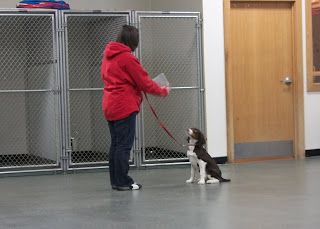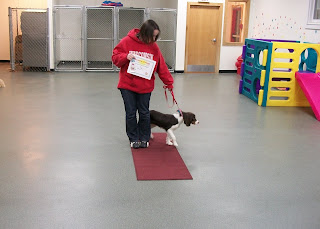Over the course of the next few weeks I will be posting information here on different sports events and trials you can participate in with your dog. It's a great thing to find an activity you and your dog can do together to help keep you both fit, physically and mentally. It also helps you to build a better closer bond wth your dog and turns them into fun but obedient pets. In a relaxed and rewarding way.
If you have any questions about this sport/event, feel free to contact
our trainer Kristi Rush at
Best Friends Pet Care in Indianapolis. For our first one we will introduce RALLY Competition information, courtesy of the American Kennel Club:
Getting Started in Rally
Rally is a sport in which the dog and handler complete a course that has been designed by the rally judge. The judge tells the handler to begin, and the dog and handler proceed at their own pace through a course of designated stations (10 - 20, depending on the level). Each of these stations has a sign providing instructions regarding the next skill that is to be performed. Scoring is not as rigorous as traditional obedience.
The team of dog and handler moves continuously at a brisk, but normal, pace with the dog under control at the handler's left side. There should be a sense of teamwork between the dog and handler both during the numbered exercises and between the exercise signs; however, perfect "heel position" is not required. Any faults in traditional obedience that would be evaluated and scored as a one-point deduction or more should be scored the same in Rally, unless otherwise mentioned in the Rally Regulations. After the judge's "Forward" order, the team is on its own to complete the entire sequence of numbered signs correctly.
Unlimited communication from the handler to the dog is to be encouraged and not penalized. Unless otherwise specified in these Regulations, handlers are permitted to talk, praise, encourage, clap their hands, pat their legs, or use any verbal means of encouragement. Multiple commands and/or signals using one or both arms and hands are allowed; the handler's arms need not be maintained in any particular position at any time. The handler may not touch the dog or make physical corrections. At any time during the performance, loud or harsh commands or intimidating signals will be penalized.
Rally provides a link from the Canine Good Citizen® (CGC) program to obedience or agility competition, both for dogs and handlers. In addition, rally promotes fun and enjoyment for dogs at all levels of competition.
What is Rally?
AKC Rally is the new dog sport that is taking the nation by storm, a successful stepping stone from the AKC Canine Good Citizen® program to the world of obedience or agility. Rally offers both the dogs and handlers an experience that is fun and energizing. The canine team moves at their own pace, very similar to rally-style auto racing. Rally was designed with the traditional pet owner in mind, but it can still be very challenging for those who enjoy higher levels of competition.
A rally course includes 10 to 20 stations, depending on the level. Scoring is not as rigorous as traditional obedience. Communication between handler and dog is encouraged and perfect heel position is not required, but there should be a sense of teamwork between the dog and handler. The main objective of rally is to produce dogs that have been trained to behave in the home, in public places, and in the presence of other dogs, in a manner that will reflect positively on the sport of rally at all times and under all conditions.
Am I Eligible?
To be eligible to compete in AKC Rally trials, a dog must be:
Registered with the AKC or listed with the AKC Purebred Alternative Listing/Indefinite Listing Privilege (PAL/ILP) program, or a Foundation Stock Service (FSS) recorded breed that meets the eligibility requirements for competition.
6 months of age or older.
The Purebred Alternative Listing/Indefinite Listing Privilege (PAL/ILP)
Dogs of any breed recognized by the AKC that do not have registration papers or known parents may qualify for a Purebred Alternative Listing/Indefinite Listing Privilege (PAL/ILP). PAL/ILP dogs may participate in certain AKC events, such as obedience, agility, tracking, rally and many performance events. Photos are required to prove the dog is a registerable breed. The dog must be spayed or neutered.
Rally Signs
The signs may be any color and they include descriptions as well as directional arrows of exercises. Signs are numbered to make it easy to find the next station when navigating the course.
All signs are placed to the handler's right side. The signs are large enough to be easily recognized when going through a course. The exercises designated on the signs will be performed in close proximity to the sign itself, either in front, back of, or beside the sign.
Role of the judge
The judge must arrive one hour before judging in order to set up the course for the class. Judges are open to questions that the handlers may have regarding the course during the walk-through period.They must post a copy of the course at ringside so that the exhibitors know what to expect and where to go once they are in the ring. The judge must evaluate the performance of each exercise and the sense of teamwork between the dog and handler between the stations as stated in the AKC Rally Regulations.
The orders "Are you ready?" and "Forward" are given to each handler who enters the ring.
Levels of Competition
The three levels of competition in AKC Rally:
Novice - this is the first level for those just getting started in competition.
All exercises are performed with the dog on leash.
There is a requirement of 10-15 stations to complete with no more than five stationary exercises.
The exercises performed vary from turning 360 degrees to changing paces during the course.
Exhibitors at this level may clap their hands and pat their legs through the course.
Advanced - this is the second level, which includes more difficult exercises throughout the course.
All exercises are performed off-leash.
There is a requirement of 12-17 stations with no more than seven stationary exercises.
Exercises include a jump as well as calling your dog to the front of you instead of to a heel position.
Excellent - this third and highest level of AKC Rally is the most challenging.
Exercises are performed off-leash except for the honor exercise.
There is a requirement of 15-20 stations, with no more than 7 stationary exercises.
Handlers are only allowed to encourage their dogs verbally. Physical encouragement is not allowed at this level.
The Excellent-level exercises include backing up three steps, while the dog stays in the heel position and a moving stand, while the handler walks around the dog.
Qualifying Performance
A qualifying performance indicates that the dog has performed the required exercises according to the AKC Rally Regulations. Each performance is timed, but times are only counted if two dogs earn the same score.
Qualifying Score
All dogs and handlers begin with a perfect 100. A dog and handler team is awarded a qualifying score if it retains at least 70 points after the course has been completed. Once the team has completed the course, their score will be posted ringside.
Awards:
The colors for placement rosettes or ribbons are the same in all levels of classes.
First Place -
Blue
Second Place -
Red
Third Place -
Yellow
Fourth Place - White
How do I get started in Rally?
Many AKC clubs conduct a variety of classes, instructed by experienced trainers who have earned titles and awards in obedience competitions with their own dogs. These people are up-to-date on the latest training techniques. They have experience training different breeds of dogs, mixed breeds and purebreds, and prospective students are usually welcome to observe a class before signing up for a training course.
When you attend a class with your dog, instructors will show you how to train your dog and will expect you to practice at home. The younger the dog, the shorter the practice sessions should be. For the best results, both you and your dog should enjoy frequent short sessions, combined with some play and rewards.
Tips for the First-time Exhibitor
Register your dog with the AKC.
Make sure that your dog is current on all inoculations and health check-ups.
Visit the AKC website to find a training club.
Attend training classes with your dog.
Become familiar with the AKC Rally Regulations.
Attend a rally trial and become familiar with ring procedures.
Don't be afraid to ask questions from experienced exhibitors.
Tips for the First-time Spectator
However tempting, do not pet a dog without first asking for and receiving permission.
Many rally trials have vendors and an information booth with helpful information for the general public.
Arrive early and bring a chair! Rally often starts very early in the morning.
If you have not yet purchased your dog, speak to exhibitors about their breeds to gain knowledge of the best dog for your family. Also, visit the "Future Dog Owners" section of the AKC website.
If you bring a baby stroller to a rally trial, be careful not run over a dog's tail. Be sure your child respects the dogs and does not grab or poke at them. Some crowded trials forbid strollers.
Rally Titles
The dogs must earn three qualifying scores under two different judges in order to receive a rally title. The titles that can be earned are:
Rally Novice:
RN
Rally Advanced:
RA
Rally Excellent:
RE
Rally Advanced Excellent:
RAE
The requirement for the RAE title is that the dog must qualify ten times in both the Advanced B class and the Excellent B class at the same trial.




























